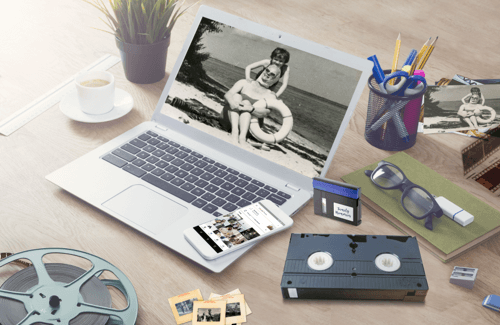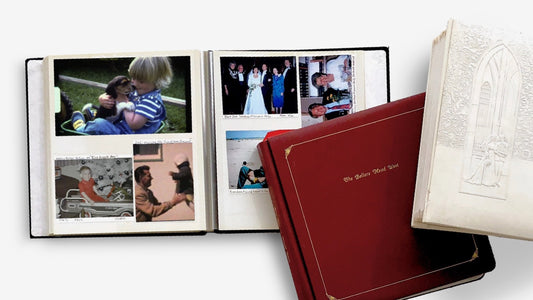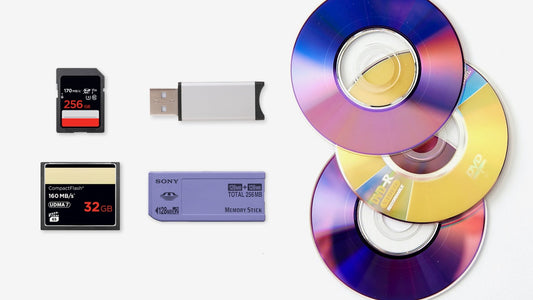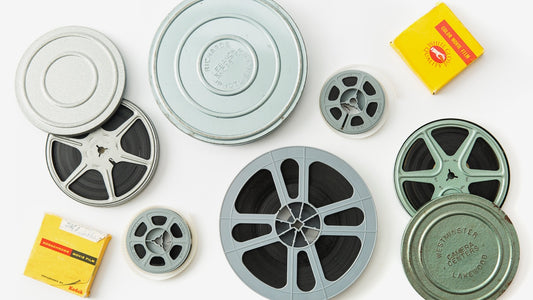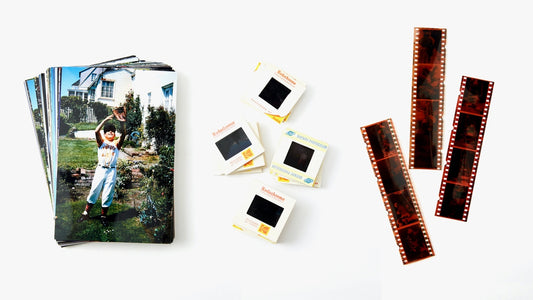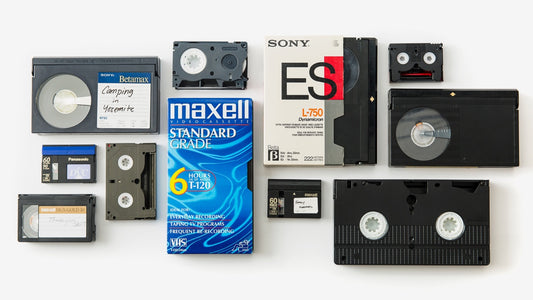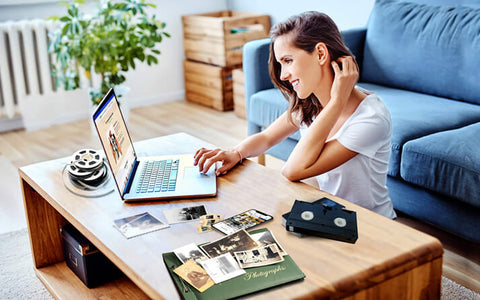You pop an old family video into the VCR, but the picture is snowy and the sound is muffled. It’s a frustratingly common problem. Before you assume the memory is lost forever, consider this: the tape might just be dirty. A simple cleaning can restore the picture and protect your VCR from damaging buildup. Knowing how to clean VHS tapes is an essential skill for anyone looking to revisit their home movies. We’ll show you how to spot the signs of a dirty tape, what tools you’ll need, and the step-by-step process for getting your memories back in focus.
Key Takeaways
- Spot the Warning Signs Before You Press Play: Always check your tapes for visual red flags like dust or white, powdery mold to avoid damaging your VCR. For cleaning, stick to high-purity (90%+) isopropyl alcohol and lint-free cloths to protect the delicate magnetic tape.
- A Fuzzy Picture is Often a VCR Problem: If multiple tapes play poorly, the issue is likely dirty heads inside your VCR, not the tapes themselves. Regularly cleaning your player is essential to prevent transferring grime between tapes and to ensure a clear picture.
- Cleaning is a Fix, Digitizing is Forever: While cleaning improves playback, it can’t stop the natural aging process of VHS tapes. The only way to permanently safeguard your home movies against future degradation is to convert them into timeless digital files.
Is It Time to Clean Your VHS Tapes?
Before you pop an old home movie into your VCR, it’s a good idea to give it a quick inspection. Over the years, dust, mold, and general grime can build up on your tapes, and playing a dirty one can damage both the memories it holds and your VCR. Figuring out if a tape needs cleaning is the first step to safely preserving it. Luckily, you don’t need to be a tech expert to spot the warning signs. By using your eyes and ears, you can quickly assess whether your tapes need a little TLC before you press play.
Spotting the Signs: What to Look and Listen For
Your senses are your best tools here. Start with a visual check of the cassette itself. Look through the clear plastic window for any obvious signs of trouble like dust, dirt, or white, powdery spots—a tell-tale sign of mold. When you play the tape, pay close attention to the picture and sound quality. If you see a fuzzy picture, snowy static, or colors that bleed and distort, it could mean the tape is dirty. Some old VHS tapes can make your VCR’s heads dirty, which causes these playback problems. Listen for muffled audio, sound that cuts in and out, or any unusual whirring or grinding sounds from the VCR, as these can also signal a dirty tape.
Your Tape's Worst Enemies: Mold and Degradation
The number one enemy of a VHS tape is mold. If your tapes have been stored in a damp or humid place like a basement or attic, there’s a good chance they’ve developed mold. It usually looks like a white or grayish powdery residue on the tape ribbon. Playing a moldy tape is a huge risk; the mold spores can get inside your VCR, clog the heads, and potentially spread to other tapes you play later. It’s a problem that can quickly get out of hand and damage your VCR. Beyond mold, the tape itself can degrade over time, becoming brittle or shedding its magnetic coating, which also calls for careful handling and cleaning.
Is a Dirty Tape Causing These Playback Issues?
Sometimes, the problem isn't the tape at all—it's your VCR. If the picture is consistently blurry or cuts out across multiple tapes, the playback heads inside your VCR are likely dirty. It can be tempting to think playing a tape will clear the debris, but this usually just moves the dirt around or pushes it deeper into the machine, potentially causing more damage. A good way to check is to use a tape you know is in good condition. If it also plays poorly, your VCR probably needs a good cleaning. If only one specific tape is giving you trouble, then the tape itself is the likely culprit. You can learn how to clean a VCR read head yourself or have a professional do it.
Everything You Need to Get Started
Before you roll up your sleeves and start cleaning, gathering your supplies will make the entire process much smoother. A little preparation goes a long way in protecting your tapes and ensuring you get the best results. Think of it as setting up your memory-saving station. Having everything within arm's reach means you can focus on the delicate task at hand without scrambling for a tool mid-clean. If at any point the process feels too overwhelming, remember that professional video transfer services are always an option to safely digitize your memories without the risk.
Your Essential VHS Cleaning Toolkit
You don’t need a professional lab to get this done, just a few key items. Most of these can be found around your house or at a local hardware store.
Here’s your shopping list:
- A working VCR: You’ll need this to play and test the tapes.
- Phillips head screwdriver: For carefully opening the tape’s casing if you need to do a deep clean.
- Isopropyl alcohol (90% or higher): The high purity is crucial for effective cleaning without leaving residue.
- Lint-free cloths or foam swabs: These are essential for cleaning the tape itself without leaving behind damaging fibers.
- Cotton swabs or Q-tips: These are great for cleaning the plastic cassette shell, but not the magnetic tape.
How to Set Up Your Cleaning Station
Find a clean, flat, and well-lit space to work, like a kitchen table or a desk. A bright area helps you spot dust, mold, or damage you might otherwise miss. Lay down a soft, clean cloth to protect both your work surface and the VHS tapes. Remember to handle the tapes gently; the magnetic ribbon inside is fragile and holds all your precious moments. Keeping your space organized and clear of clutter will help you work carefully and prevent any accidental spills or damage to your collection.
Safety First: Protecting Yourself and Your Tapes
When working with any cleaning solution, safety is key. Isopropyl alcohol is flammable, so be sure to work in a well-ventilated area away from any open flames or sparks. It’s also a good idea to wear gloves to protect your skin. For your tapes, the biggest safety rule is using the right kind of alcohol. Using a solution that is 90% pure or higher ensures it will evaporate quickly and won't leave behind water or other additives that can cause residue and damage the delicate magnetic tape over time.
What Not to Use: Common Cleaning Mistakes
Just as important as what you use is what you don't use. Never apply household cleaners, water, or any other liquid besides high-purity isopropyl alcohol to the magnetic tape itself. Also, avoid using paper towels or regular cotton balls for cleaning the internal tape ribbon. These materials can shed tiny fibers that get caught in the tape or, even worse, in your VCR’s heads during playback. Sticking to lint-free materials is the best way to ensure you’re removing grime, not adding more debris to the mix.
Always Practice on a Test Tape First
If you’re feeling a bit nervous about cleaning a tape of your wedding or a baby’s first steps, grab a tape you don’t care about first. A recorded TV show or a movie you can easily replace is the perfect candidate for a practice run. This allows you to get comfortable with the process and build your confidence. You can even use an old, spare VCR to fast-forward and rewind the test tape a few times. This helps knock off any loose dust and ensures the tape is properly tensioned before you begin cleaning.
A Step-by-Step Guide to Cleaning VHS Tapes
Ready to give your old tapes some much-needed attention? Cleaning VHS tapes is a delicate process, but with a little patience and a gentle hand, you can clear away years of dust and grime. This guide will walk you through the process step-by-step, from a basic inspection to tackling tougher issues like mold. Remember, the goal is to preserve the memories stored on these tapes, so working carefully is key. Let’s get started.
Step 1: Inspect the Tape
Before you do anything else, take a close look at the tape. Hold the cassette in your hands and check the outer shell for any cracks or damage. Then, peek through the clear windows to look at the tape itself. Do you see any obvious dust, debris, or white, fuzzy spots that could be mold? Gently press the small button on the side to release the flap and get a better view of the tape section that’s exposed. Always be very careful when handling VHS tapes because the magnetic tape inside is delicate and can be easily damaged. This initial inspection will tell you what kind of cleaning job you’re in for.
Step 2: Clean the Cassette Casing
Start with the easy part: the plastic cassette. A clean casing prevents dust and dirt from getting inside your VCR. Take a soft, lint-free microfiber cloth and gently wipe down the entire exterior of the VHS tape. If you encounter some stubborn spots, you can slightly dampen the cloth with distilled water, but be extremely careful not to let any moisture seep inside the cassette or touch the magnetic tape. A clean tape is a great first step, but for long-term preservation, the best way to keep your memories safe is by digitizing your home movies so you don't have to worry about physical degradation again.
Step 3: Tackle Stubborn Grime
If you notice some grime on the plastic casing that a simple wipe-down won’t remove, you can use a bit of isopropyl alcohol. Grab a cotton swab and dip it in alcohol that is 90% pure or higher. Lower-purity alcohol contains more water, which can leave behind residue. Squeeze out any excess liquid from the swab—it should be damp, not dripping. Carefully use the swab to clean the affected areas on the plastic shell, staying far away from the magnetic tape itself. This is perfect for removing old sticker residue or other sticky spots that have collected dust over the years.
Step 4: Safely Remove Mold
Seeing mold on your tapes can be alarming, and it requires a special approach. First, never put a moldy tape into your VCR. Playing a moldy VHS tape is risky because the mold spores can get into your machine and damage its internal components, not to mention spread to other tapes you play later. To clean it, you’ll need to carefully open the tape’s flap and manually advance the film, gently wiping the moldy sections with a soft, lint-free cloth dampened with high-purity isopropyl alcohol. This is a very delicate task, and if the mold is extensive or the tape is especially precious, consider getting professional help to avoid causing permanent damage.
Step 5: Test Your Clean Tape
Once you’ve cleaned your tape and it is completely dry, it’s time to see how you did. If you have a secondary VCR that you don’t mind putting at risk, it’s best to use that one for the first playback. This way, if there’s any remaining residue or debris, it won’t harm your main player. Pop the tape in and play it through. Watch the playback quality and listen for any unusual sounds. If the picture is clearer and the sound is better, your cleaning was a success! If you’re still seeing issues, the problem might be with your VCR heads, not just the tape.
Bonus Step: Don't Forget Your VCR
A clean tape is only half the battle; you also need a clean VCR. Dirty heads can transfer grime right back onto your freshly cleaned tapes and cause fuzzy playback. The best way to clean VCR heads is to do it by hand. Unplug the VCR and remove its cover. You’ll see a shiny, angled cylinder—that’s the head drum. Take a piece of regular printer paper (don’t use cotton swabs, which can leave fibers behind) and fold it. Dampen the edge with high-purity isopropyl alcohol. Gently press the paper against the drum and use your finger to spin the drum counter-clockwise. Don’t move the paper up and down. After a few rotations, you’ll have a clean set of heads ready for your tapes.
Pro Tips for Tricky Tapes and VCRs
Sometimes, a tape needs a little extra attention, especially if it’s been sitting in storage for decades. If you’re dealing with a particularly stubborn tape or a VCR that’s seen better days, these advanced tips can help you get a clearer picture. Remember to always work gently, as old tapes can be extremely fragile. If a tape contains irreplaceable memories and seems too damaged to handle, consider letting a professional take a look. The most important thing is to preserve those moments, and sometimes that means calling in for backup.
Prepare Tapes for Playback with a Test VCR
Before you play your freshly cleaned tape in your main VCR, it’s a smart move to run it through a test player first—one you wouldn’t mind getting a little dirty. Think of it as a quarantine for your tapes. This simple step ensures that any lingering dust doesn't get transferred to your good machine, potentially damaging its playback heads. If the picture is consistently blurry across several tapes, the problem is likely with the VCR's heads. However, if only one specific tape is giving you trouble, then the tape itself is the likely culprit. Using a test VCR helps you diagnose the issue without risking your primary equipment. For those truly irreplaceable tapes, if you're still having trouble after cleaning, letting a professional service handle the video transfer is the safest way to protect those memories.
How to Manually Clean VCR Heads
If your VCR’s picture is fuzzy or snowy, dirty heads are the likely culprit. For a deep clean, you can do it manually. You’ll need rubbing alcohol that’s at least 90% pure and either a piece of high-quality paper or a foam swab. Gently spin the shiny, cylindrical VCR head drum counter-clockwise with one finger. With your other hand, lightly press the alcohol-dampened paper or swab against the side of the drum as it spins. Don’t press down from the top. You can also use cotton swabs to carefully clean other parts along the tape’s path, like the rollers and guides.
Cleaning the Pinch Roller and Other Parts
While the VCR heads get most of the attention, don't overlook the other parts that guide your tape. The pinch roller, a small black rubber wheel, is a key player. It works with a metal pin to pull the tape through the machine at a consistent speed. If it’s caked with grime, the tape can slip, causing a wobbly picture or distorted sound. To clean it, dampen a piece of a coffee filter with high-purity isopropyl alcohol and gently wipe the roller until the residue is gone. A coffee filter is a great choice because it cleans effectively without leaving any lint behind. You can also use cotton swabs to clean the other stationary guides along the tape’s path. Keeping all these VCR components clean helps your player run smoothly and prevents it from transferring dirt back onto your tapes.
Using a VCR Head Cleaner Tape the Right Way
The simplest way to clean your VCR is with a head cleaner tape. While they’re not as common as they used to be, you can still find them online. These special cassettes are designed to safely and gently remove dust and oxide buildup from the VCR heads as they "play." Most are "dry" systems, meaning they don't use any harsh chemicals that could damage the delicate components inside your machine. Just pop the cassette in and press play for about 20-30 seconds. It’s one of the easiest methods for routine maintenance.
A Word of Caution on Head-Cleaning Tapes
Using a head-cleaning tape can feel like a quick and easy fix, but it’s wise to be a little cautious. These tapes are often abrasive and can wear down the delicate playback heads over time, which are essential for a clear picture. Instead of pulling out all the dust and grime, they sometimes just push it deeper into your VCR’s internal parts, which can cause bigger problems later on. It’s better to think of them as a tool for a light dusting, not a deep clean, especially for a player that hasn’t been used in years and needs more serious attention.
For a much safer and more effective job, cleaning the heads by hand is the way to go. A lint-free swab or a piece of clean paper with a bit of high-purity isopropyl alcohol lets you gently remove buildup without the risk of scratching anything. This doesn’t mean you should throw out your head-cleaning tape; it’s still useful for a quick touch-up now and then. But for a VCR with really stubborn playback issues, taking a few extra minutes to manually clean the heads will almost always give you a better result and help your machine last longer.
How Often Should You Clean Your Tapes and VCR?
To keep your home movies looking their best and protect your VCR from buildup, it’s a good habit to clean your VCR heads regularly. For the best results, many preservation experts recommend cleaning the heads between each tape you play. This might sound like a lot, but it prevents the dirt and residue from one tape from being transferred to the next. A quick run with a head cleaner tape is usually enough for this kind of preventative maintenance, saving the manual cleaning for when you notice more serious playback issues.
Handling Fragile, Old, or Damaged Tapes
Older tapes require a gentle touch. The magnetic tape inside the cassette becomes brittle over time and can easily snap or get tangled. Always hold the cassette by its outer shell and avoid touching the tape itself. When inserting or ejecting a tape, do it slowly and deliberately. If a tape seems stuck, don't force it. For tapes with visible damage, like a cracked casing or wrinkled tape, the safest option is to let a professional service handle the video transfer. It’s not worth risking the only copy of a precious memory.
How to Splice a Snapped VHS Tape
It’s a heart-sinking moment when you hear a strange noise from the VCR and discover your favorite home movie has snapped. Before you panic, know that you can often repair a broken tape with a little patience. You’ll need a small Phillips head screwdriver, non-magnetic scissors, and proper mylar splicing tape—regular Scotch tape is too thick and will gum up your VCR. Carefully unscrew the cassette shell and gently lift the top off. Find the two broken ends of the magnetic tape and trim them to create clean, straight edges. Overlap the ends slightly and apply a small piece of the splicing tape to the non-shiny side, pressing firmly. Once it’s secure, carefully wind the repaired section back onto the spools and reassemble the cassette.
Keep in mind that the spliced section will cause a brief glitch—a moment of static or a jump in the video—during playback. This fix is a great way to recover the footage, but it's not a perfect, long-term solution. The repaired area is a weak point that could snap again. If the tape holds irreplaceable memories, like your parents' wedding or your first birthday, the safest way to preserve it for good is to have it professionally repaired and digitized. Services like our video transfer can handle fragile tapes, ensuring your memories are protected from any future physical damage and can be enjoyed for generations to come.
Solving Common Playback and Cleaning Issues
If your video playback is blurry, jumpy, or cutting out, the first step is always to clean the VCR heads. This simple fix solves most common picture quality problems. However, be on the lookout for mold. If you play a moldy tape, the spores can contaminate your VCR and then spread to every other tape you play afterward. This can cause permanent damage to both your tapes and your player. If you suspect a tape has mold, it’s best to isolate it and seek professional help for cleaning and digitization, like this VHS cleaner that saved some childhood home videos.
Advanced Cleaning: Using an Electronic Tape Cleaner
If you have a large collection of tapes or are dealing with more than just surface dust, an electronic tape cleaner can be a great investment. This method is much gentler on the delicate magnetic tape than manual scrubbing because it doesn't use harsh chemicals and provides a consistent, even clean. To get started, you’ll need the electronic cleaner itself, a VCR for testing, high-purity rubbing alcohol, and some cotton swabs. Simply place the tape into the cleaner and let it run through its cycle. Once it’s finished, you can take the extra step of opening the cassette’s flap and using a cotton swab dipped in alcohol to gently wipe the empty plastic reel inside, catching any lingering dust.
Last Resort: Manually Cleaning the Magnetic Tape
This next method should only be attempted if an electronic cleaner didn't solve the problem, as it carries a high risk of permanently damaging your tape. If you decide to proceed, put on a pair of soft, cotton gloves to protect the tape from the oils on your hands. Carefully lift the side flap on the cassette and gently pull out about a foot of the magnetic tape. Using a clean, dry, lint-free cloth, very gently wipe the exposed tape ribbon. It’s critical that you do not use any cleaners, alcohol, or even water directly on the magnetic surface, as this can strip the recording from the tape. Given the risks, if a tape holds irreplaceable memories, it's much safer to have it professionally digitized.
Debunking Cleaning Myths: The Blank Tape Method
You may have heard the old trick of playing a new, blank VHS tape to clean your VCR’s heads. Unfortunately, this is a myth that can do more harm than good. Most preservation experts agree that this method is ineffective at removing any significant amount of dirt or grime. In fact, running a new tape through a dirty machine can actually push debris deeper into the VCR heads or simply move it around, making the problem worse. Instead of relying on this method, it’s always better to clean the heads directly using the manual technique with isopropyl alcohol or a dedicated head-cleaning cassette to ensure you’re actually removing the buildup, not just compacting it.
Preserving Your VHS Collection for the Future
Cleaning your tapes is a huge step, but the job isn’t finished until they’re safely stored. Proper preservation is all about protecting your tapes from the elements that cause them to break down over time. Think of it as creating the perfect environment for your memories to live in until you’re ready to watch them again. The magnetic tape inside each cassette is delicate and susceptible to heat, humidity, and dust. Taking a few extra precautions can add years to the life of your collection, ensuring those family holidays and childhood birthdays remain viewable for as long as possible. It’s about playing the long game, and a little bit of care now goes a long way in preventing future heartbreak from a ruined tape.
The Dos and Don'ts of VHS Tape Storage
Where you keep your tapes matters more than you might think. The ideal spot is cool, dry, and dark, away from direct sunlight and extreme temperature changes. Attics and basements are often too humid or prone to temperature swings, which can lead to mold growth and tape degradation. Instead, opt for a closet in the main part of your house. Always store your tapes upright in their cases, like books on a shelf. This prevents the tape from sagging and getting damaged. And be sure to rewind each tape completely before putting it away. This helps keep the tape tension even and reduces stress on the film.
Handle with Care: Preventing Unnecessary Damage
Every time you handle a VHS tape, you have an opportunity to protect it. Always be very careful, because the magnetic tape inside is delicate and can break easily. Hold the cassette by its outer shell and avoid touching the tape ribbon itself. Oils from your skin can cause damage over time. It’s also critical to keep your tapes away from anything that creates a magnetic field, like speakers, TVs, or microwaves, as magnets can erase the footage. Before storing a tape, make sure it's completely dry, especially if it was recently cleaned or kept in a humid place. Trapped moisture is a primary cause of mold and decay.
Simple Maintenance for a Lasting Collection
A little upkeep can make a big difference for both your tapes and your VCR. One of the best habits to get into is cleaning your VCR heads between each tape you play. Dust and debris from one tape can easily transfer to the next, causing playback issues or even scratching the film. You can use a folded piece of printer paper and some strong rubbing alcohol to gently wipe the heads clean. Playing your tapes every few years also helps prevent the layers of magnetic tape from sticking together. Think of it as giving your memories a little exercise to keep them in good shape.
Know When to Call a Professional
Sometimes, a tape needs more help than you can provide at home. If you come across a tape with a snapped ribbon, a cracked casing, or a severe mold problem that you’re not comfortable handling, it’s time to call in an expert. Trying to fix major issues yourself can often lead to permanent damage. Similarly, if your VCR is eating tapes or the picture is consistently blurry or cutting out, the problem might be with the machine itself. A professional can assess the situation and often recover footage from even the most hopeless-looking tapes, saving memories you thought were lost for good.
The Cost of Professional-Grade Equipment
If you have a large collection or are dealing with serious issues like mold, you might consider investing in some professional-grade equipment. The costs can vary quite a bit depending on what you need. On the lower end, essential maintenance supplies are fairly affordable. You can find a basic VCR head cleaner for around $10, and professional grade splicing tape for repairing snapped film is about $16. However, for more serious restoration, the price goes up. A dedicated device like the VHS IS LIFE mold removal machine, designed to tackle heavy-duty cleaning, will set you back around $100. When you add up these costs, especially for a one-time project, it’s worth weighing the investment against the number of tapes you need to restore.
For a Permanent Fix, Digitize Your Tapes
While proper storage and cleaning can extend the life of your VHS tapes, they can’t stop the slow march of time. Every tape in your collection is gradually degrading and will eventually become unplayable. The only permanent way to protect your home movies is to digitize them. Converting your tapes into digital files creates a perfect, ageless copy that won’t fade, warp, or break. You can easily watch them on any device, share them with family online, and store them securely in the cloud. A professional video transfer service is the safest and most reliable way to preserve your memories forever.
Related Articles
- What To Do With Old VHS Tapes: Recycle, Convert & More – YesVideo
- 4 Easy Ways to Convert VHS to DVD at Home – YesVideo
- What To Do With Old VCR Tapes: A Practical Guide – YesVideo
- Converting VHS to DVD: The Ultimate 2024 Guide – YesVideo
Frequently Asked Questions
Is it really safe to clean my precious home movies myself? That’s a great question, and it’s smart to be cautious. For tapes with minor dust or grime, following the steps carefully is generally safe. If you're feeling nervous, I always recommend doing a practice run on a tape you wouldn't be heartbroken to lose, like an old movie recorded off the TV. However, if a tape is your only copy of a wedding or a baby's first steps, and it looks to be in rough shape, the safest route is always to trust a professional service.
My tape has a lot of white stuff on it. How much mold is too much to handle on my own? Any amount of visible mold is a serious concern because the spores can damage your VCR and spread to other tapes. If you only see a few tiny, isolated spots, you might be able to clean it carefully yourself. But if the mold looks widespread, fuzzy, or seems to be deep within the tape spools, it's best to stop. That level of contamination requires special equipment to handle safely without risking your health or your VCR.
What should I do if the tape ribbon is snapped or tangled? If the magnetic tape itself is broken, tangled, or pulled out of the cassette, don't try to fix it or put it in your VCR. Attempting to splice the tape at home with something like scotch tape can permanently damage the footage and, more importantly, can break the heads inside your VCR. This is definitely a situation where you should seek out a professional transfer service, as they have the tools to safely repair and digitize the footage.
Why is using high-purity isopropyl alcohol so important? Can't I just use the kind in my medicine cabinet? It’s crucial to use isopropyl alcohol that is 90% pure or higher. The rubbing alcohol you typically find in a first-aid kit is often only 70% pure, meaning the other 30% is mostly water. That extra water can leave behind residue, fail to evaporate quickly, and even encourage more mold growth over time. The high purity stuff cleans effectively and vanishes without a trace, which is exactly what you want for the delicate magnetic tape.
After cleaning, the picture is still fuzzy. Does that mean the tape is ruined? Not necessarily, so don't panic! More often than not, a fuzzy or snowy picture is caused by dirty heads inside your VCR, not the tape itself. Debris from one tape can easily get left behind on the heads and affect the playback of the next one. Before you assume the tape is a lost cause, try giving your VCR heads a thorough manual cleaning. This simple step solves the vast majority of playback problems.
Tips for the Best Digitizing Quality
The quality of your digital copy hinges entirely on the playback quality you can get from the original tape. For the clearest picture, always start with a clean VCR. It’s a great habit to clean the VCR heads between each tape you digitize to prevent dust from one tape from affecting the next. When you clean, stick to isopropyl alcohol that is 90% pure or higher; the common 70% version from a first-aid kit contains too much water and can leave behind damaging residue. While cleaning improves playback, it can’t stop the tape’s natural aging process. For your most irreplaceable memories, the surest way to get a high-quality, permanent copy is by using a professional video transfer service with equipment designed to pull the best possible signal from aging tapes.





